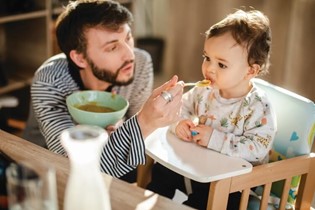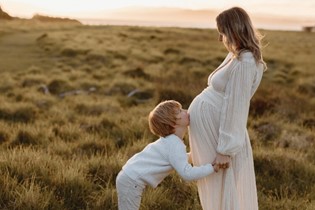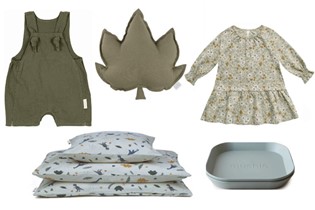Spin me right 'round, Baby! Advice for helping baby be in the best position for birth

Fetal positioning varies from mama to mama. We look at how the supported pregnancy and labour positions of Spinning Babies may help people find space in their pelvis, and freedom in birth.
When Jessica Tye was in labour with her twins, Lachlan and Finn, the first baby boy was born safely, as expected. But when it was her second twin’s time to engage, his heart rate dropped. Her obstetrician wanted to put a scalp monitor on the head of the unborn boy to check his pulse, but Jessica was reluctant for intervention. Instead, her midwife Claire Eccleson got her into a position taught in the Spinning Babies methodology – the ‘abdominal lift and tuck’.
After a short while in the supported position, her second twin dropped down in her uterus and engaged in her pelvis. “The position was quite pivotal in being able to birth my second twin vaginally without any medication or instrumental delivery” shares Auckland-based Jessica proudly. “I think it would have been quite different without those techniques.”
Jessica believes that without the position-encouragement her birth may have ended in instrumental intervention such as forceps, or an emergency Caesarean section. Many mums who reach the late stages of pregnancy and find their baby hasn’t engaged in the birth canal often find themselves without many options. Jessica had a midwife to advocate for her, but not all mums are as able to stick to their birth plan when the unexpected happens.
External Cephalic Version (ECV), a method wherein the doctor presses on the belly to encourage baby to move, is a route most women are encouraged to take if their baby is in the breech (feet first) position. But if that doesn’t work, a C-section or intervention such as forceps is generally recommended.

While C-sections are a wonderful tool for complicated or at-risk births, vaginal births are still considered the least risky and optimal way to birth for healthy mamas. But due to a number of factors, including medicalisation of birth, the number of women who have C-sections has doubled globally since 2000. In Aotearoa, around one quarter of births are via C-section, which is well-above the World Health Organisation's recommended rate of 10 percent.
But variations of normal, such as breech and posterior (baby facing away from the back) births, don’t necessarily have to end in a C-section if parents don’t want one. There’s other methods to try first. Enter Spinning Babies; a practical array of tools that don’t advocate for a particular birthing method or stand against C-sections, but offer gentle positioning and balancing techniques that aim to create more space for the baby in the womb.
The techniques can potentially optimise maternal space in the soft tissues, such as muscles and ligaments, plus the bones of the pelvis. In turn, this might support fetal repositioning; gently encouraging babies to turn and engage correctly in later pregnancy and in labour. Ideally, a baby should be head-down, facing mum’s back with its chin tucked in ready to go through the pelvis. Spinning Babies uses physiology to encourage babies to turn, without ever forcing or manually pushing them to. “Rather than just focusing on cervical dilation, Spinning Babies asks where the baby is in the pelvis, then uses simple, gentle hands-on techniques to create space,” shares Claire – a midwife and Spinning Babies practitioner, with 20 years of birth experience.
Claire says babies have an “innate intelligence” that allows them to get into position for birth, and with the right relaxation and physiological techniques for mama, we can help them find room to engage if they’re struggling on space. Before becoming an approved trainer with Spinning Babies, Claire ran workshops under the name Sunnyside Up, helping birth workers and parents overcome challenges related to babies being in the posterior position.

Parents can really benefit from physical preparation for birth, explains Claire. She says Spinning Babies offers suggestions to increase pregnancy comfort and ease in birth, as many medical professionals have lost the knowledge for birthing breech babies, meaning planned C-sections are
ever-increasing. Spinning Babies was started to connect people with their bodies, and create space in the pelvis using simple, biomechanics-based techniques. “A baby who’s breech might be so because the cord is tight or because the mother’s soft tissues are tight and there’s less available space in the lower segment of the uterus,” Claire says. “What Spinning Babies does is offer techniques to invite spaciousness, and once you’ve got more space you’ve got more movement and then the baby will hopefully come into the available space.”
Whilst there isn’t yet any conclusive research on whether Spinning Babies’ techniques actually work, the anecdotal support is huge and extends globally. Started in the United States by midwife Gail Tully in 2001, the methods offer a range of pregnancy and labour techniques that encourage babies to move, rather than forcing them into position by pressure or intervention. “It’s mum’s job to dilate, it’s baby’s job to rotate,” says Gail in one promotional video. As many mums who have birthed in hospitals or birth centres might know, the focus is hugely on dilation, with less of a lens on baby’s rotation and how to manually encourage that. Claire says many births now end in C-section because of “labour taking longer than expected, which can be due to the baby needing more support and space to navigate the pelvis.”
Jessica’s experience, where Claire encouraged her to use the popular ‘abdominal lift and tuck’ move, focuses on a posterior pelvic tilt, and is made possible by straightening the back, bending the knees and holding the belly up a few inches. It’s one of many positions and techniques recommended by Spinning Babies, some others being ‘the jiggle’, which vibrates the legs and buttocks to encourage fluids in the muscle tissue to move for a calming effect, ‘the side lying release’, which opens and softens the pelvis, and ‘the forward-leaning inversion’, which creates space in the lower pelvis using an upside down position, utilising gravity.
When I attended a workshop Claire was hosting in Hamilton, she was teaching a group of birth workers some key Spinning Babies techniques. She’d repeatedly hold a model pelvis up in front of the class, demonstrating its ability to open, move and soften. Many techniques require the help of a partner or support person, so the room was filled with doulas, midwives and birth educators all holding and embracing one another. Permission is key and each woman gently asked the other if they could touch places such as the lower back and buttocks before engaging in any movement. Some are suggested for during pregnancy, some for early labour and some are reserved solely for during contractions.
Partner-assisted techniques can be particularly helpful for making pregnancy a joint affair between mama and partner. Partners can respond to the pregnant mama’s needs by using supportive, approved techniques that hold their partner or offer them space in their limbs by gentle pressing, pulling and moving.
Auckland mum-of-two Ashleigh Hayward describes how she found the inclusion of a partner in the physical postures especially helpful during her last pregnancy with her daughter, Tairi-Jean. It enabled her partner to connect to the pregnancy experience, and the hands-on techniques helped them work on comfort together. “A lot of the time you’ll be complaining to your partner and they can’t do much except heat a wheat bag or listen to you, but with Spinning Babies, they can do techniques with you and feel like they are part of the journey of pain.”
The techniques connected her to her body, teaching her that our modern lifestyle, where we sit down often, isn’t necessarily the most comfortable for a baby in the womb. “We often forget that everyday things such as sitting at work or driving aren’t favourable for getting a baby into position,” she says. During her pregnancy, she practised Spinning Babies, which she feels helped her prepare for the strength required in birth. Tapping into relaxation through partner-based exercises also helped. “There were a couple of actions that we did with the sarong. My partner wrapped it around my bum and pelvis and it just felt amazing. There was nothing that gave me more relaxation during pregnancy than that move. It was better than a massage.”
Comfort-centred positioning is honoured throughout the principles. Common birth practises can be detrimental to both comfort and creating space for babies, Claire explains. She points out that pregnant people are commonly told to lie on their back with their legs apart when giving birth, but she sees this as a flaw in the current norm. “That’s a position that’s actually counter-productive to creating more space,” she says. It’s a birthing position we commonly see in movies; the pregnant woman lying back on the bed with her knees bent and open. But it’s not optimal for pelvic opening, stresses Claire.
Relaxation is also an important element of pregnancy and labour that can be overlooked in the modern birth paradigm. “Birth is something that happens through your body, it’s not something that happens through your brain,” Claire says. “A lot of people prepare their brain, but they leave out the physicality.” She suggests breathing as a great way for people to connect with their bodies, and get out of their heads. “Breathe in through your nose or mouth and give the out-breath down through the pelvis and out through the vagina. Sometimes it’s about creating a sense of spaciousness within the nervous system, so some of the techniques are about promoting that downregulation into the parasympathetic nervous system,” she says.
Spinning Babies focuses on slowing down, softening and strengthening simultaneously. “It’s applicable for a home birth, birthing centre and also a really complex hospital birth,” explains Claire. “Even if someone requires lots of medical care, you can still respect and work with physiology in that situation.” Twin mum Jessica agrees: “It’s something you can do in your own space and in your own time. It’s a really effective, gentle technique and a great option for all expectant mums.
Words: India Hendrikse

AS FEATURED IN ISSUE 56 OF OHbaby! MAGAZINE. CHECK OUT OTHER ARTICLES IN THIS ISSUE BELOW

















